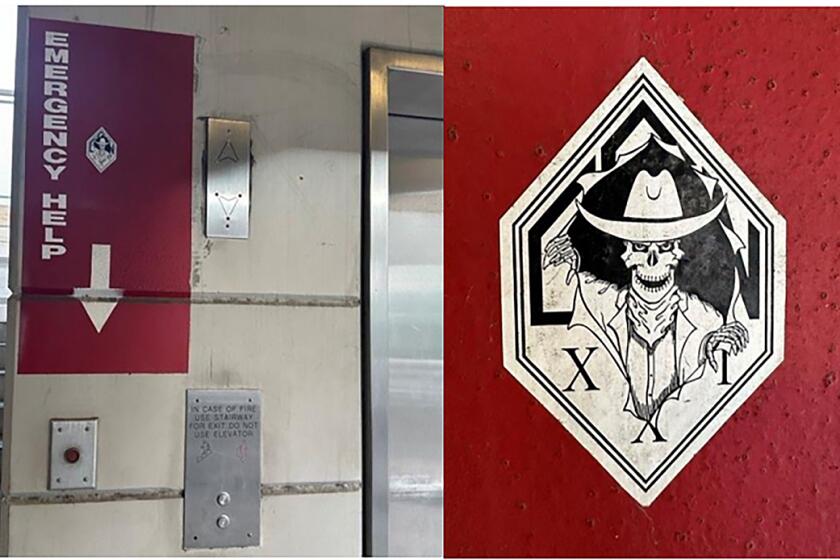Lawsuit alleges deputy gang ‘shot-caller’ boasted about gruesome death of fleeing suspect

- Share via
Six years ago, a plumber found the decomposing body of Raymundo Rivera inside a pillar at a Winco supermarket in Lancaster. At the time, Los Angeles County Sheriff’s Department officials said the 35-year-old appeared to have fled during a traffic stop and may have “gotten inside there and gotten down to try and hide from the deputies and then couldn’t get out.”
But according to a lawsuit filed Wednesday in L.A. Superior Court, former Deputy Aaron Tanner later boasted that he and other deputies had chased Rivera — and that they knew he’d fallen into the pillar. Instead of trying to save him, the suit says, “the deputies left him there to die, and made false reports that they lost track of the suspect in the pursuit.”
The allegations came to light this week when Tanner’s ex-girlfriend filed a $5-million lawsuit accusing him of physically abusing her for more than two years. The woman, who is identified only as Jane Doe in court filings, also alleged the ex-lawman bragged about being a “shot-caller,” or leader, in a deputy gang known as the Rattlesnakes. According to the suit, he also threatened to have other members of the group “take care of her” if she told anyone about his alleged abuse.
Tanner could not be reached for comment Wednesday, and it was not clear whether he had an attorney. State records show he has not been employed by the Sheriff’s Department since late last year.
In addition to raising a litany of other claims about Tanner — including an on-duty incident in which he allegedly cut off a dead horse’s leg — the suit also describes repeated misconduct involving other members of the Rattlesnakes. According to the complaint, Tanner told his ex the group effectively controls the Lancaster Sheriff’s Station and that its members allegedly intimidate other deputies, make false arrests and frame people. Until now, the group has so far garnered little scrutiny compared to more notorious deputy groups operating in East L.A. and Compton.
The suit, filed by attorney Vincent Miller, accuses the county of allowing deputy gangs to persist despite promises to reform.
Late Wednesday, the Sheriff’s Department said in a statement that it had not officially received the complaint but that it “does not condone any acts that violate the civil rights of others” and is working to hold deputies accountable.
“The department has been conducting several comprehensive deputy gang investigations that have never been done before and for the first time we have fired employees for violating the existing deputy cliques and subgroups policy,” the statement said. “Additionally, the department has updated training programs, re-briefed personnel about deputy gangs and behavior that could have adverse career consequences and created a task force to generate lasting, cultural change.”
The move came in response to a Times report about a violent incident involving a group of off-duty deputies, some of whom allegedly belonged to a previously unreported gang at the City of Industry sheriff’s station.
The soured relationship that sparked the lawsuit began in March 2020, when Jane Doe began dating Tanner. The deputy allegedly told her he was an influential member of a “gang” called the Rattlesnakes. According to the suit, he told her that members of the group would withhold backup on other deputies’ patrol calls “to endanger their lives,” write false police reports and engage in other “illegal conduct.”
But the crux of the claims center on Tanner’s alleged abuse and “sadistic tendencies.” In the 17-page filing, Doe accuses the deputy of repeatedly strangling her until she was unconscious, allegedly telling her he needed to do it to maintain “dominance” over her. According to the suit, Doe didn’t report Tanner to authorities because she was afraid of retaliation by other members of the Rattlesnakes.
“Jane Doe saw how powerful Tanner and the Rattlesnakes were, and how they controlled the Lancaster Station,” the suit continues, offering as an example an incident that started when Tanner allegedly told his girlfriend to follow behind him in her car. He drove at a high speed, the suit says, then slammed on the brakes so suddenly that her car crashed into his.
When a bystander called 911, Tanner allegedly called dispatch and told them not to send help.
In late 2022, Doe broke off her relationship with Tanner. Afterward, she alleges, he and other Rattlesnakes members stalked her at work, “terrorizing and intimidating her.” Then in 2023, the suit says, the department began investigating Tanner and officials contacted Doe about an unrelated incident she allegedly witnessed during an unauthorized ridealong with him.
However, Doe was reluctant to talk because she suspected one of the investigating sergeants was a member of the Rattlesnakes and might tell her ex what she would say. Still, the suit says, the department ended up opening an internal criminal investigation into Tanner. Two other deputies allegedly told the department’s internal crime investigators that Tanner had been withholding backup from other deputies and that they’d reported it to the station captain.
“When they reported the withholding of back up,” the suit says, “the captain quickly moved to cover up the deputy gang activity at the station, telling the deputies to never tell him about this again and to ‘get the f— out of my office.’”
In addition to the internal criminal probe, the suit says Tanner was the target of multiple administrative investigations, including one incident in which he allegedly sawed off the leg of a dead horse with a pocketknife and made a trainee hold the leg. The suit doesn’t clarify when the incident supposedly took place, what the deputy allegedly did with the detached leg or why it was removed in the first place.
Now, the department’s probe is “wrapping up,” the suit says, and investigators are “reportedly confident the DA will indict Tanner for the violence committed against Jane Doe and the use of his gang to intimidate the witness.” He has also been given a notice of termination, the suit says.
The district attorney’s office did not immediately respond to a question about whether prosecutors have already been asked to review any cases involving the former deputy.
A former Los Angeles County sheriff’s deputy has sued the county, alleging he was retaliated against and wrongly fired.
For decades, the Sheriff’s Department has been plagued by allegations about gangs of deputies running roughshod over certain stations and floors of the jail. The groups are known by monikers such as the Indians, the Vikings and the Regulators, and their members often bear the same sequentially numbered tattoos with symbols linking them to specific stations.
Some of the groups — such as the Compton Executioners and the East L.A. Banditos — have become frequent targets of oversight investigations, lawsuits and independent reports.
But aside from the allegations in this week’s lawsuit, there is relatively little known about the Lancaster group. When the Civilian Oversight Commission’s special counsel released a 70-page report on deputy gangs last year, the Rattlesnakes got one fleeting mention. Two years earlier, a 230-page county-commissioned Rand Corp. report on the groups referenced the Rattlesnakes just three times, describing them as one of a few tattooed groups that did not appear to be actively adding members.
That same year, a 54-page report written by researchers at Loyola Law School described the group as “a deputy gang operating out of the Palmdale and Lancaster stations in the Antelope Valley.”
The report described the group’s tattoo as a skull and a snake, but it didn’t list any suspected members or allegations of misconduct. The report said it wasn’t clear whether the tattoos were sequentially numbered.
Yet it appears the Rattlesnakes have been on the federal government’s radar since at least 2013, when a U.S. DOJ report raised concerns about a tattooed group of deputies in the Antelope Valley. The report detailed the findings of an investigation into allegations of racially discriminatory policing practices in the area in northern Los Angeles County.
“Some Antelope Valley deputies wear tattoos or share paraphernalia with an intimidating skull and snake symbol as a mark of their affiliation with the Antelope Valley stations,” the report said. “Though there are varying interpretations of what these tattoos symbolize, they provide an undeniable visual representation of the gulf between deputies and the community and are an unfortunate reminder of LASD’s history of symbols associated with problematic deputy behavior.”
At the time, Sheriff’s Department officials “assured” the U.S. DOJ they were trying to suppress the “skull and snake image.” But federal authorities noted in their report that the images were still “widely visible throughout the Antelope Valley.” The report encouraged the Sheriff’s Department to take stronger measures to get deputies to stop displaying such “divisive” insignia.
Following the report, in 2015 the county entered into a settlement agreement with the federal government, promising to correct some of the policing problems authorities had identified.
More than a decade later, this week’s lawsuit accuses the county of failing to take meaningful action to rein in tattooed deputy subgroups in the Antelope Valley or across the county. The complaint outlines a laundry list of wrongdoing linked to other tattooed groups, including the Banditos, which operate out of the East L.A. Sheriff’s Station.
The suit says the groups’ members have been disciplined for “stealing money from residents, destroying evidence, writing false police reports, lying in the course of investigations, recklessly killing children, and intimidating witnesses.”
The suit asks for money for attorney’s fees, interest and damages, including from severe emotional distress.
More to Read
Sign up for Essential California
The most important California stories and recommendations in your inbox every morning.
You may occasionally receive promotional content from the Los Angeles Times.












